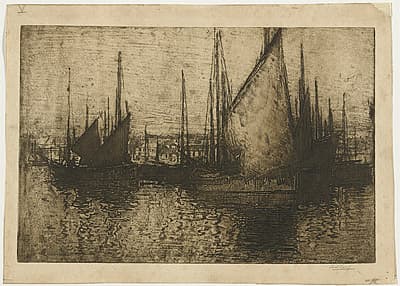
Sydney
LONG
Australia
1871
–
London
1955
England, Europe 1910-21; Australia 1921- 22; England 1922-25; Australia 1925-52; England from 1952
20.4 (h) x 30.8 (w) cm
undesignated impression , published state , edition of 30 , no manufacturer's mark
Signed lower right below plate-mark in black pencil, 'Sid Long [underlined]'. Not dated. Not titled.
Reference: Mendelssohn (1979), 23; Paul (1928), 27 National Gallery of Australia, Canberra NGA 1977.9.23 The Stephen Collection, purchased 1976. Reproduced with the kind permission of the Ophthalmic Research Institute of Australia
- J.W.F. Stephen, who formed a definitive collection of the etched work of Sydney Long. J.A.C. Stephen, the artist’s son, by descent. Purchased by the Australian National Gallery, from J.A.C. Stephen, Sydney, 1977.
When Long first visited St Ives in 1911 he wrote: ‘I am fixed up in a studio built on a rock right on the bay in fact in rough
weather the waves splash up the windows which have to be closed. I had intended to take a studio belonging to [Algernon] Talmage but he wanted too much for it.
Just fancy, I only pay 30/— a month for the one I have and it is furnished with cooking stove and W.C. attached. Of course they are only big lofts over the fishermen’s houses which have been converted into studios
but they serve the purpose excellently.
St. Ives is a quaint old place and I am hoping to get some interesting stuff here’ (Long,
23 October 1911).
Long revisited St Ives numerous times, delighting in the light, the sea air, and the community of artists. In this print he showed his delight in the shapes of the sails and masts of the boats jostling in the harbour. And he took advantage of the texture
of softground etching to convey the shimmering reflections on the water.
Dorothy Ellsmore Paul dated the print 1918, but this date is now believed to be incorrect as Long did not start printmaking until 1918, and this is not among the prints he mentions in his early correspondence about printmaking. It is now dated 1920 on the basis of its inclusion in the exhibition
The water-colours and etchings of Sydney Long, ARE, Decoration Galleries, Melbourne,
15–26 August 1921 (6 or 7). A copy of this print is held by the Tasmanian Museum and Art Gallery. And a copy was given by Long to the British Museum, London, in 1924.
When Long first visited St Ives in 1911 he wrote: ‘I am fixed up in a studio built on a rock right on the bay in fact in rough
weather the waves splash up the windows which have to be closed. I had intended to take a studio belonging to [Algernon] Talmage but he wanted too much for it.
Just fancy, I only pay 30/— a month for the one I have and it is furnished with cooking stove and W.C. attached. Of course they are only big lofts over the fishermen’s houses which have been converted into studios
but they serve the purpose excellently.
St. Ives is a quaint old place and I am hoping to get some interesting stuff here’ (Long,
23 October 1911).
Long revisited St Ives numerous times, delighting in the light, the sea air, and the community of artists. In this print he showed his delight in the shapes of the sails and masts of the boats jostling in the harbour. And he took advantage of the texture
of softground etching to convey the shimmering reflections on the water.
Dorothy Ellsmore Paul dated the print 1918, but this date is now believed to be incorrect as Long did not start printmaking until 1918, and this is not among the prints he mentions in his early correspondence about printmaking. It is now dated 1920 on the basis of its inclusion in the exhibition
The water-colours and etchings of Sydney Long, ARE, Decoration Galleries, Melbourne,
15–26 August 1921 (6 or 7). A copy of this print is held by the Tasmanian Museum and Art Gallery. And a copy was given by Long to the British Museum, London, in 1924.
When Long first visited St Ives in 1911 he wrote: ‘I am fixed up in a studio built on a rock right on the bay in fact in rough
weather the waves splash up the windows which have to be closed. I had intended to take a studio belonging to [Algernon] Talmage but he wanted too much for it.
Just fancy, I only pay 30/— a month for the one I have and it is furnished with cooking stove and W.C. attached. Of course they are only big lofts over the fishermen’s houses which have been converted into studios
but they serve the purpose excellently.
St. Ives is a quaint old place and I am hoping to get some interesting stuff here’ (Long,
23 October 1911).
Long revisited St Ives numerous times, delighting in the light, the sea air, and the community of artists. In this print he showed his delight in the shapes of the sails and masts of the boats jostling in the harbour. And he took advantage of the texture
of softground etching to convey the shimmering reflections on the water.
Dorothy Ellsmore Paul dated the print 1918, but this date is now believed to be incorrect as Long did not start printmaking until 1918, and this is not among the prints he mentions in his early correspondence about printmaking. It is now dated 1920 on the basis of its inclusion in the exhibition
The water-colours and etchings of Sydney Long, ARE, Decoration Galleries, Melbourne,
15–26 August 1921 (6 or 7). A copy of this print is held by the Tasmanian Museum and Art Gallery. And a copy was given by Long to the British Museum, London, in 1924.
